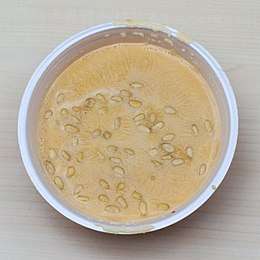Guriev porridge
Guryev porridge (Guriev kasha) is a Russian porridge (kasha) dessert dish prepared from semolina and milk with the addition of nuts (hazelnut, walnuts, almonds), kaimak (creamy foams) and dried fruits.[1][2][3] Traditional preparation of the dish involves preparing milk skins and separating the dish's ingredients by layers with the skin between each layer.[4] It is considered a traditional dish of Russian cuisine, but it was invented only at the beginning of the 19th century.

History
The name of Guriev porridge comes from the name of Count Dmitry Alexandrovich Guriev (1751–1825), Minister of Finance and member of the State Council of the Russian Empire.[1]
It has been stated that Guryev porridge was invented by Zakhar Kuzmin, a serf chef of the retired major of the Orenburg dragoon regiment Georgy Jurisovsky, who was visited by Guryev. Subsequently, Guriev bought Kuzmin with his family and made him a regular chef in his court. According to another version, Guryev himself came up with a recipe for porridge.[1]
It was a beloved dish of Emperor Alexander III.[1] Prior to the October 17, 1888 train crash that Alexander III was on, the emperor was served this dish for dessert.[1] When the waiter came to the emperor to pour the cream, a terrible blow occurred, and the train derailed.[1]
References
- Goldstein, D.; Mintz, S. (2015). The Oxford Companion to Sugar and Sweets. Oxford University Press. p. 597. ISBN 978-0-19-931362-4. Retrieved July 22, 2017.
- Schillinger, Liesl (September 13, 2013). "The Sickle of Plenty: Mastering the Art of Soviet Cooking". The Daily Beast. Retrieved July 22, 2017.
- Molokhovets, E.; Toomre, J. (1998). Classic Russian Cooking: Elena Molokhovets' a Gift to Young Housewives. Indiana-Michigan Series in Rus. Indiana University Press. p. 334. ISBN 978-0-253-21210-8. Retrieved July 22, 2017.
- Goldstein, D. (1999). A Taste of Russia: A Cookbook of Russian Hospitality. Russian Life Books. pp. 87–88. ISBN 978-1-880100-42-4. Retrieved July 22, 2017.